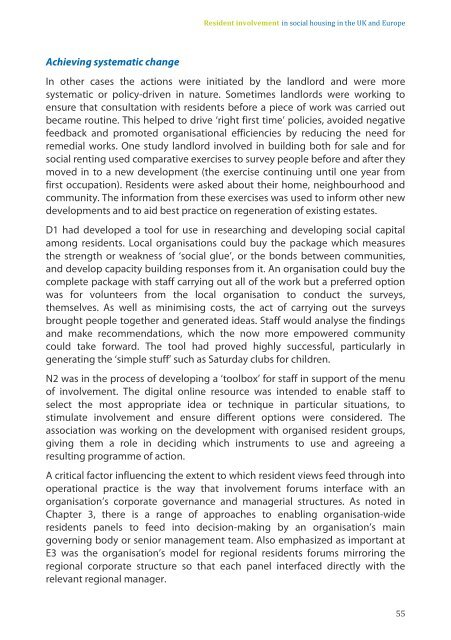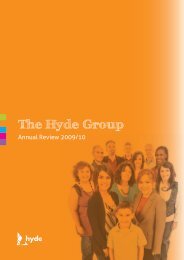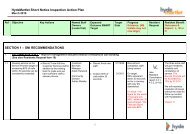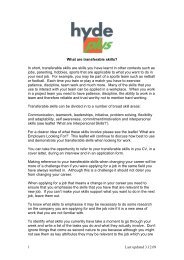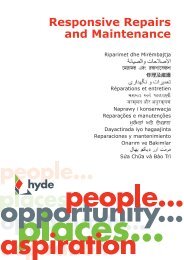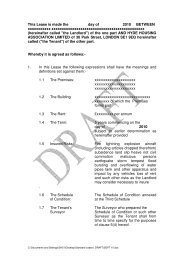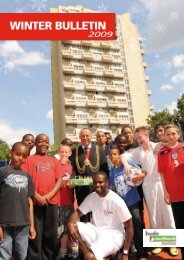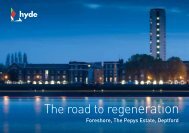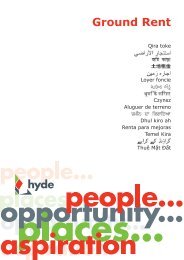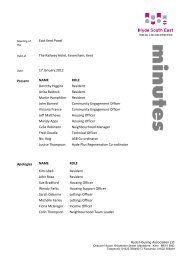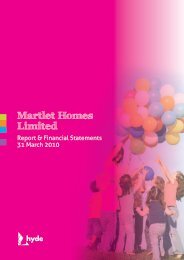Resident involvement - Hyde Housing Association
Resident involvement - Hyde Housing Association
Resident involvement - Hyde Housing Association
Create successful ePaper yourself
Turn your PDF publications into a flip-book with our unique Google optimized e-Paper software.
<strong>Resident</strong> <strong>involvement</strong> in social housing in the UK and Europe<br />
Achieving systematic change<br />
In other cases the actions were initiated by the landlord and were more<br />
systematic or policy-driven in nature. Sometimes landlords were working to<br />
ensure that consultation with residents before a piece of work was carried out<br />
became routine. This helped to drive ‘right first time’ policies, avoided negative<br />
feedback and promoted organisational efficiencies by reducing the need for<br />
remedial works. One study landlord involved in building both for sale and for<br />
social renting used comparative exercises to survey people before and after they<br />
moved in to a new development (the exercise continuing until one year from<br />
first occupation). <strong>Resident</strong>s were asked about their home, neighbourhood and<br />
community. The information from these exercises was used to inform other new<br />
developments and to aid best practice on regeneration of existing estates.<br />
D1 had developed a tool for use in researching and developing social capital<br />
among residents. Local organisations could buy the package which measures<br />
the strength or weakness of ‘social glue’, or the bonds between communities,<br />
and develop capacity building responses from it. An organisation could buy the<br />
complete package with staff carrying out all of the work but a preferred option<br />
was for volunteers from the local organisation to conduct the surveys,<br />
themselves. As well as minimising costs, the act of carrying out the surveys<br />
brought people together and generated ideas. Staff would analyse the findings<br />
and make recommendations, which the now more empowered community<br />
could take forward. The tool had proved highly successful, particularly in<br />
generating the ‘simple stuff’ such as Saturday clubs for children.<br />
N2 was in the process of developing a ‘toolbox’ for staff in support of the menu<br />
of <strong>involvement</strong>. The digital online resource was intended to enable staff to<br />
select the most appropriate idea or technique in particular situations, to<br />
stimulate <strong>involvement</strong> and ensure different options were considered. The<br />
association was working on the development with organised resident groups,<br />
giving them a role in deciding which instruments to use and agreeing a<br />
resulting programme of action.<br />
A critical factor influencing the extent to which resident views feed through into<br />
operational practice is the way that <strong>involvement</strong> forums interface with an<br />
organisation’s corporate governance and managerial structures. As noted in<br />
Chapter 3, there is a range of approaches to enabling organisation-wide<br />
residents panels to feed into decision-making by an organisation’s main<br />
governing body or senior management team. Also emphasized as important at<br />
E3 was the organisation’s model for regional residents forums mirroring the<br />
regional corporate structure so that each panel interfaced directly with the<br />
relevant regional manager.<br />
55


